Theodore Parker Lukens House
Introduction
Text-to-speech Audio
One of the oldest private homes in Pasadena, this Victorian house was built for realtor and horticulturalist Theodore Parker Lukens from 1886 to 1887. Lukens was a charter member of the Sierra Club and carried out the first reforestation experiments in California in 1892 by planting thousands of pine trees in burned-out areas in the San Gabriel Mountains above Pasadena. Lukens wrote the first promotional booklet on Pasadena and later served as President of the City Council and on many local boards. Lukens died in 1918. The T.P. Lukens House became a National Register of Historic Places listing in 1984 at which time it was owned by the Kislingbury family.
Images
Front (east) of Lukens House in 1983 photo for NRHP (Paul Graunke)
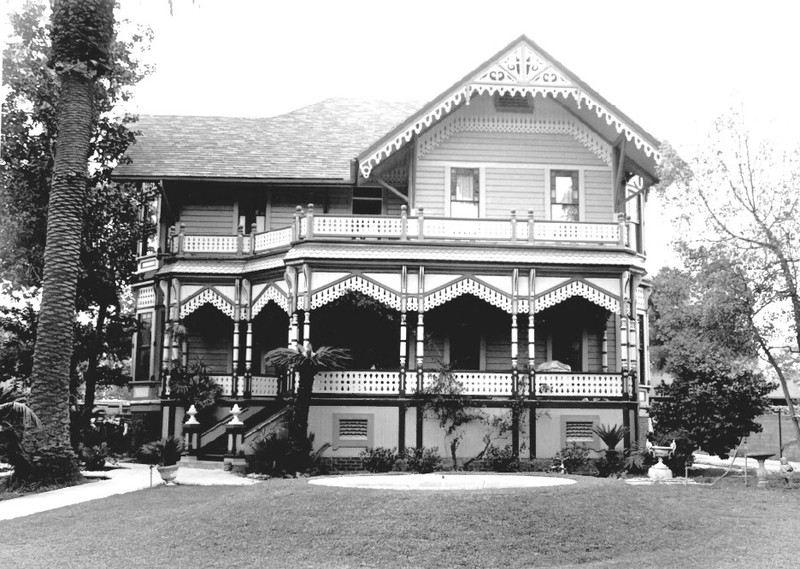
North side of Lukens House in 1983 (P. Graunke)
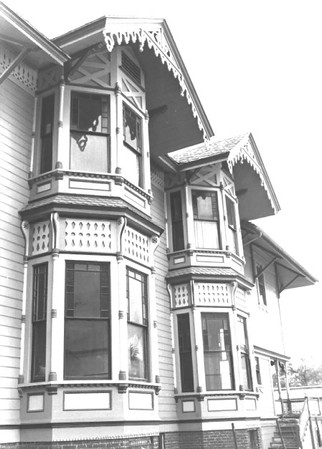
Detail of bay windows on south side of Lukens House (P. Graunke 1983)
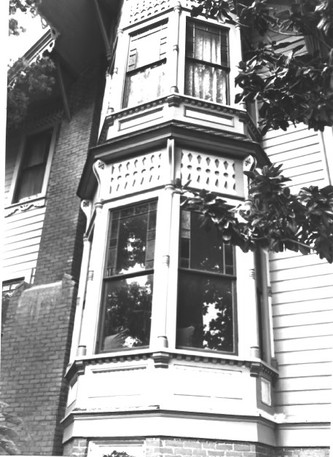
Rear of Lukens House with circa 1901 extension of second floor, viewed from backyard (P. Graunke 1983)
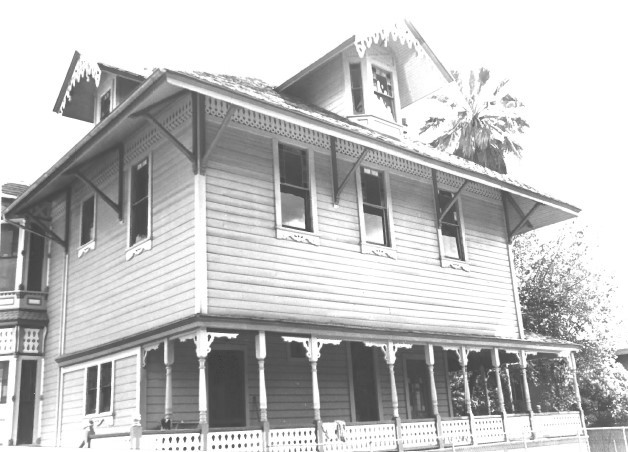
1895 photo of Lukens (right) with naturalist John Muir (Celia Crocker)
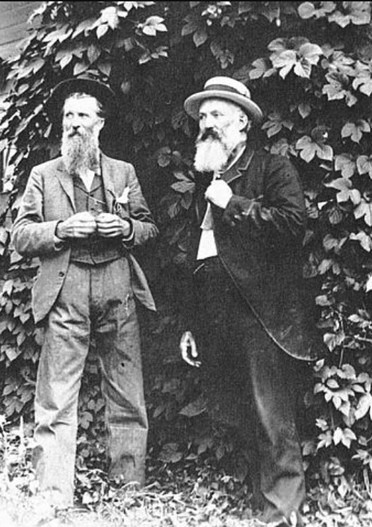
Detail of Lukens' own ad in his 1886 promotional booklet on Pasadena (p. 30)
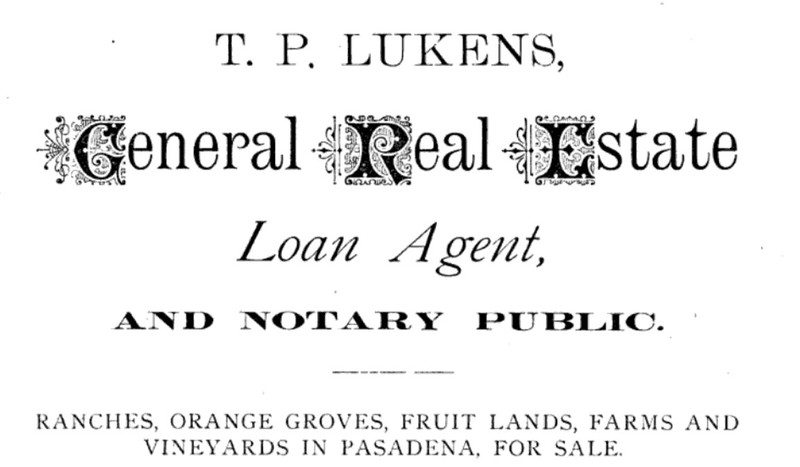
Backstory and Context
Text-to-speech Audio
One of the oldest houses in Pasadena, the Theodore Parker Lukens House, stands on El Molino Ave. across from the Locust St. intersection. Lukens had the wood frame home built from 1886 to 1887 on a six-acre lot. Harry Ridgway, the first architect to open an office in Pasadena, designed the house. Although Ridgway was responsible for designing hundreds of homes, commercial, and public buildings in town, he did not restrict himself to particular architectural styles and preferred to combine elements from multiple styles. Only two of Ridgway's Victorian homes have survived in Pasadena, one being the Lukens House. The house, mainly in Stick/Eastlake and Queen Anne styles, is notable for its abundant wooden trim and the spacious front porch with balcony above. The rear (west) porch originally was one-story and wrapped around onto the north and south sides of the home. The kitchen was later extended into part of the rear porch, the porch was limited to the rear side of the house, and the second story was extended to cover the porch. In the 1970s, three small gabled dormers were added to the roof.
Lukens was a Midwesterner who moved to Pasadena in 1880 at age 32. He became a local realtor (the first in Pasadena) and horticulturalist who was a charter member of the Sierra Club in 1894. In 1895, he met naturalist John Muir on a Sierra Club outing and the two became friends for life. Lukens has been called the "father of forestry" and was the namesake behind Mt. Lukens in the San Gabriel Mountains and Lake Lukens in Yosemite National Park. He carried out the first experiments of reforestation in California in 1892 by planting thousands of pine trees in the San Gabriel Mountains above Pasadena. He took thousands of photographs, detailed notes, and botanical specimens from the local mountains in the 1890s.
Lukens was an enthusiastic promotor of the new town of Pasadena which underwent a building boom in the mid-1880s. He wrote the first promotional booklet on the town - Pasadena, California, Illustrated and Described, Showings its Advantages As a Place for Desirable Homes (1886). In the booklet, Lukens boasted of sixty substantial buildings under construction in Pasadena that year (one of which would have been the El Molino Ave. house). Besides serving as Pasadena's mayor (President of the City Council) from 1890-1892, Lukens was involved in local libraries, banks, schools, and newspapers.
Lukens married Charlotte, a Vermont native, in 1870; the couple went on to have one child. In 1900, Theodore (age 51) shared a house he owned at 195 N. Marengo Ave. with his wife, Charlotte (67), housekeeper Mary A. Patch (50), and a boarder/teacher, Mimi Martin (40). Lukens listed his occupation as a forester and farmer. Perhaps the El Molino Ave. home was rented out or sold by 1900. Mr. Lukens died in 1918.
When the Lukens House was documented for listing in the National Register in the early 1980s, the house was owned by Roger E. Kislingbury. Mr. Kislingbury preserved and restored the home's exterior and was undertaking a restoration of the interior. The front lawn featured mature palm trees and a ten-foot-wide circular pond with a fountain.
Sources
Graunke, Cheryl. NRHP nomination of Theodore Parker Lukens House, Pasadena, California. National Register. Washington, DC. National Park Service, 1983.
Lukens, Theodore P. Pasadena, California, Illustrated and Described, Showings its Advantages As a Place for Desirable Homes . Pasadena, CA. T.P. Lukens, 1886.
U.S. Census Bureau. Household of Theodore P.A. Lukens at 195 N. Marengo Ave., Pasadena District 114, California, dwelling 141, family 146. Washington, DC. U.S. Government, 1900.
National Park Service (NPS): https://npgallery.nps.gov/AssetDetail/NRIS/84000879
NPS: https://npgallery.nps.gov/AssetDetail/NRIS/84000879
NPS: https://npgallery.nps.gov/AssetDetail/NRIS/84000879
NPS: https://npgallery.nps.gov/AssetDetail/NRIS/84000879
https://en.wikipedia.org/wiki/Theodore_Lukens#/media/File:MuirandLukens.jpg
Lukens 1886 in Google Books: https://books.google.com/books/about/Pasadena_California_Illustrated_and_Desc.html?id=2oQrAQAAMAAJ
